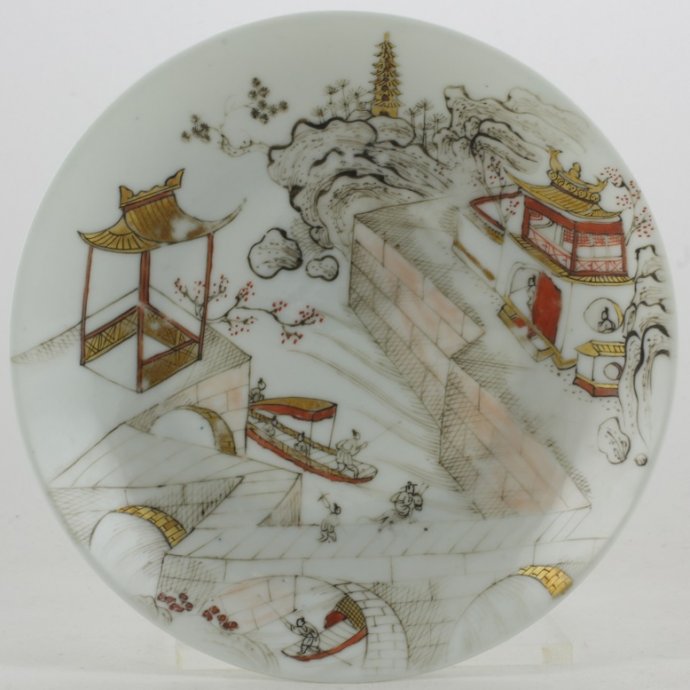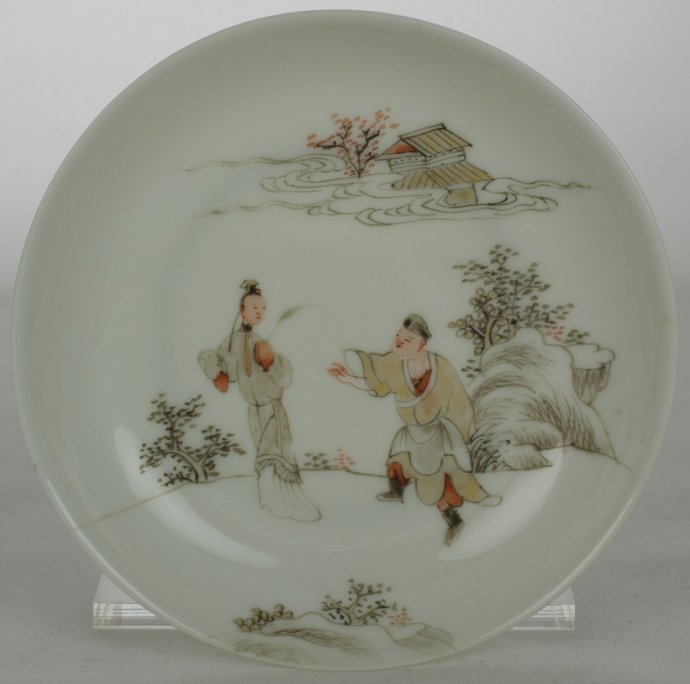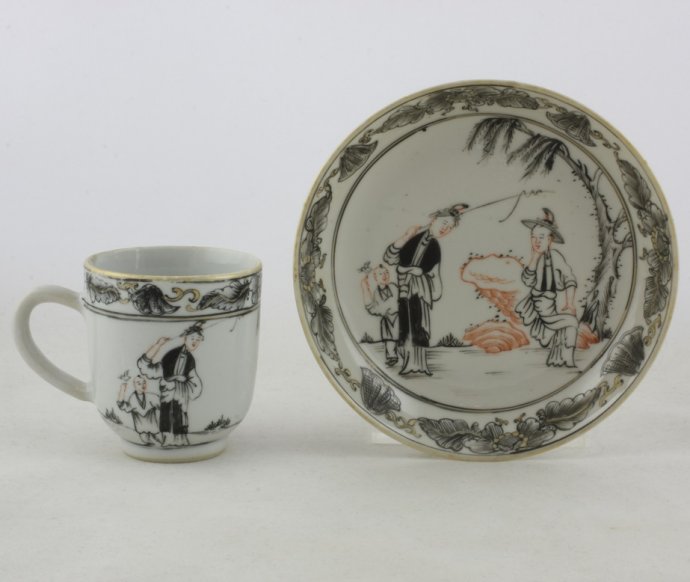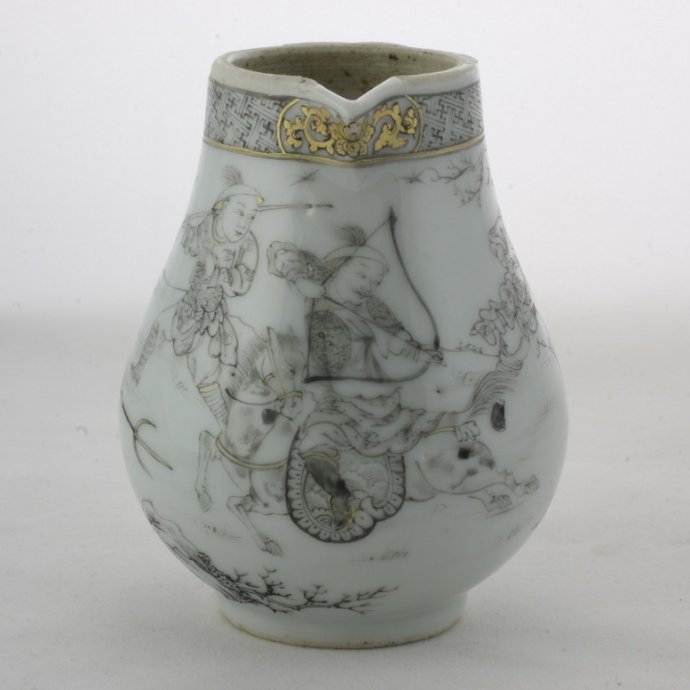Sold Ceramics
Sold Encre de Chine 1725-1775
Page 1
The use of black enamel in imitation of drawings or prints was first developed at the end of the reign of the Kangxi emperor (1662-1722) and the Yongzheng reign (1723-1730). Chinese porcelains decorated in ink colour became popular in Europe around 1740, and until about 1790 continental clients continued to order them, especially for armorials, because the ink-colour process so readily duplicated the engraved bookplates supplied to the decorators as source materials. The technique may have been developed first for use on glass in the 1660s in Germany, where it was called schwarzlot. Eighteenth-century shipping records sometimes may have referenced it as pencilled ware because it was executed with a thin brush called a pencil. Albert Jacquemart dubbel it encre-de-Chine. Another name Jesuit ware was used still later due in part to the many examples of ceramics with religious motifs that incorporated this technique. En grisaille, another popular term used to refer to this technique, is inappropriate as it refers to works in various media in shades of gray and brown, and it does not convey the quality or technique evident in them. The Dutch terms were zwart geemailleerd or zwart goed (black-eneameled or black goods), and the state inventory of Johannes van Bergen van der Gijp (1713-1784) lists his porcelain as swarte kunst (black art). Works incorporating the reddish enamel known in China as zhucai (yellowish-red colour-or sepia often are grouped with ink-colour wares as well. (Sargent 2012, pp.333-334)
In 1722 Père d'Entrecolles reported that the Chinese were experimenting with painting in black, so far unsuccessfully. Black or schwarzlot, decoration, was also then just being developed in Europe, and in fact the German Hausmaler was putting it primarily on Chinese imported in the white, rather than on wares from the newly established Meissen factory. It must have been these hybrids that were sent back to Canton for imitation at the time of Père d'Entrecolle's letter, but the perfection of the technique and its translation into commercial export porcelain came only later, under the direct influence of the Du Paquier period (1719-1744). Unique to the Viennese Du Paquier factory was the laub- und bandelwerk border, based on two series of engravings by Paul Decker (d.1713). Continually modified and varied its essential elements were strapwork, palmettes, trelliswork cartouches, and foliate scrolls combined into a rhythmical pattern of baroque formality. Other China trade versions of the laub- und bandelwerk border, such as the more usual one with the addition of peacock and with panels of quilting rather than trellis- or scale work, are farther removed from their Viennese factory prototypes, and are perhaps derived from Hausmaler variants. (Corbeiller 1974, pp.68-69)

Sold Ceramics - Sold Encre de Chine 1725-1775 - Page 1
Object 2012135
Saucer
China
c.1730
Height 20 mm (0.79 inch), diameter of rim 116 mm (4.57 inch), diameter of footring 65 mm (2.56 inch), weight 53 grams (1.87 ounce (oz.))
Saucer on footring, slightly everted rim. Decorated in overglaze iron-red, gold and black enamel with a boy riding on the back of a water buffalo in a mountainous landscape with rocks and a tree. In one hand the boy is holding his hat and a stick while his other hand is reaching out with a bird perched on his fingers looking at another bird in flight. Round the rim a diaper-pattern ground with three reserves filled leafy flower heads. The reverse is undecorated.
For similarly decorated objects, please see:
- Sold Ceramics - Sold Shipwreck Porcelains - Unidentified Shipwreck wares - Page 1 - Object 2010503.
-
Sold Ceramics - Sold Shipwreck Porcelains - Unidentified Shipwreck wares - Page 1 - Object 2010564.
Condition: Perfect.
Reference:
Price: Sold.

Sold Ceramics - Sold Encre de Chine 1725-1775 - Page 1
Object 2011819
Bowl
China
c.1730
Height 56 mm (2.20 inch), diameter of rim 118 mm (4.65 inch), diameter of footring 55 mm (2.17 inch), weight 107 grams (3.77 ounce (oz.))
Published: Fraeylema Nieuws, number 52, September 2015
Bowl on footring, spreading sides and upturned rim. Decorated in various enamels and encre de Chine with two flower sprays and beetles and butterflies. Around the rim a diaper-pattern border. On the bottom an orchid (Cymbidium virescens) (only visible in ghost form).
On this bowl the Chinese porcelain painter's interest in insects, evident from the Wanli period onwards, is combined with encre de Chine which allowed finely and detailed painting. The encre de Chine decorating style was used not only for reproducing European prints, but also for decorations in the Chinese style as applied here on this bowl. (Jörg & Van Campen 1997, p.169, cat. 186 & p.221, cat. 251)
The orchid (Cymbidium virescens), the Lan Hua. is a motif commonly seen on fine Chinese export porcelain of around 1740.
Condition: Wear to the blue enamel. a very tiny glaze hairline (3 mm (0.12 inch) to the rim only visible on the inside and a hairline to the base.
References:
Jörg & Van Campen 1997, cat. 186 & 251
Fraeylema Nieuws, number 52, September 2015
Price: Sold.

Sold Ceramics - Sold Encre de Chine 1725-1775 - Page 1
Object 2011706
Saucer
China
1730-1735
Height 16 mm (0.63 inch), diameter of rim 114 mm (4.49 inch), diameter of footring 64 mm (2.52 inch), weight 47 grams (1.66 ounce (oz.))
Saucer on footring, slightly everted rim. Decorated in encre de Chine with gold, iron-red and a light pinkish gold wash with a river scape with trees, mountains, pagodas and various figures in a fortress within walls, in boats, on bridges and on horseback. The reverse is undecorated.
Condition: A fleabite and a frit to the inner footring.
Price: Sold.

Sold Ceramics - Sold Encre de Chine 1725-1775 - Page 1
Object 2010687
Saucer
China
1730-1735
Height 16 mm (0.63 inch), diameter of rim 91 mm (3.58 inch), diameter of footring 52 mm (2.05 inch)
Saucer on footring, slightly everted rim. Decorated in encre de Chine with gold, iron-red and a light pinkish gold wash with a man reaching out towards a woman holding a stem in a landscape. The reverse is undecorated.
Condition: Perfect.
Price: Sold.
More pictures of object 2010688, another identically shaped, sized and decorated, sold saucer >>

Sold Ceramics - Sold Encre de Chine 1725-1775 - Page 1
Object 2011375
Cup and saucer
China
1750-1770
Height of cup 63 mm (2,48 inch), diameter of rim 56 mm (2.20 inch), diameter of footring 30 mm (1.18 inch), weight 76 grams (2.68 ounce (oz.))
Height of saucer 23 mm (0.91 inch), diameter of rim 121 mm (4.76 inch), diameter of footring 75 mm (2.92 inch), weight 68 grams (2.40 ounce (oz.))
Cup and saucer on footrings, the saucer with a slightly flaring rim, the tall cup with handle. Decorated in encre de Chine, brown and gold with a lady is seated on rockwork under a pine tree conversing with another lady and child. Round the rims decorative borders in the style of Viennese Du Pacquier porcelain with floral scrolls alternating with shells.
Condition cup: A glaze rough spot to the underside of the handle, three frits and a hairline (only visible on the inside) to the rim (two frits filled).
Condition saucer: Some popped bubbles of glaze to the rim, caused during the firing process, a firing flaw in the centre, a fleabite and frit to the rim.
Reference:
Price: Sold.

Sold Ceramics - Sold Encre de Chine 1725-1775 - Page 1
Object 2010897
Milk jug
China
1750-1770
Height 86 mm (3.38 inch), diameter 69 mm (2.72 inch), diameter of mouthrim 35 mm (1.38 inch), diameter of footring 38 mm (1.50 inch)
Milk jug on a footring, pear shaped body with handle, small triangular spout at the rim. The cover is missing. The handle is placed opposite the spout. Decorated in encre de Chine with gold with a "stag hunting scene". On the rim a swastika pattern border and four reserves filled with flowering scrolls.
Condition: A hairline to the rim.
Reference:
Price: Sold.
More pictures of object 2010898, another identically decorated, sold coffee cup >>
More pictures of object 2010875, another identically decorated, sold spoon or leak tray >>


 create websites
create websites